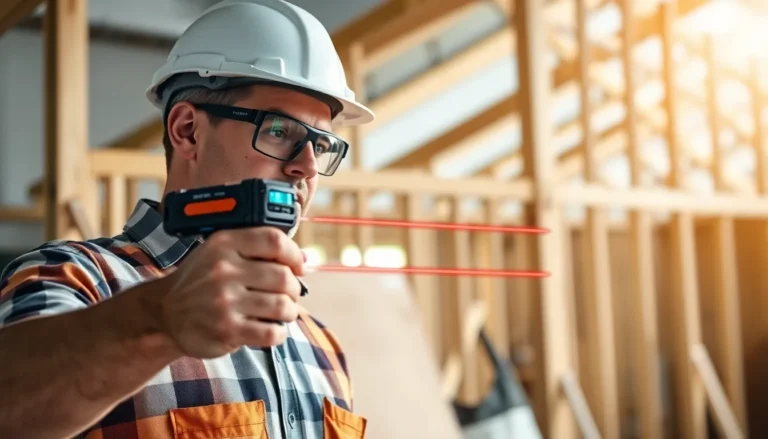Table of Contents
ToggleIn a world where your toaster can chat with your fridge, it’s time to embrace the future of living. Smart home devices aren’t just for tech geeks anymore; they’re for anyone who wants to turn their humble abode into a futuristic haven. Imagine a home that knows you better than your best friend—adjusting the lights when you enter, playing your favorite tunes, and even reminding you to water that poor, neglected plant.
Overview of Smart Home Devices
Smart home devices enhance daily living through automation and connectivity. These gadgets simplify tasks, increasing comfort and efficiency. A range of products exists, including smart speakers, thermostats, security cameras, and lights. Each device offers unique features tailored to specific needs.
Smart speakers, such as Amazon Echo and Google Nest, allow users to control other devices using voice commands. With built-in virtual assistants, these speakers streamline interactions, providing easy access to information and entertainment. Smart thermostats, including Nest and Ecobee, optimize energy consumption. They learn user preferences, adjusting temperatures accordingly to save energy.
Security cameras like Ring and Arlo provide peace of mind. Users monitor their homes in real-time through smartphone applications, receiving alerts for unusual activity. Smart lighting systems, such as Philips Hue and LIFX, enhance ambiance while offering energy savings. Through smartphone apps, individuals customize brightness and colors.
Smart home hubs, like Samsung SmartThings and Wink, connect various devices, creating a unified ecosystem. Centralized management allows users to control multiple products from one interface. Additionally, smart appliances, including refrigerators and ovens, improve convenience. They offer features such as remote monitoring and alerts for maintenance needs.
Integration across devices ensures a seamless experience. Users can establish routines wherein devices respond together, enhancing overall functionality. Enhanced security features also protect user data and privacy. Established manufacturers prioritize security, regularly updating device firmware.
Overall, today’s smart home devices cater to a range of lifestyles, making technology accessible for everyone. The future promises even more connectivity, enhancing how homes respond to inhabitants’ needs.
Benefits of Smart Home Devices
Smart home devices deliver a range of advantages that transform everyday living into a more efficient experience. They cater to various needs, ensuring enhanced comfort and protection.
Enhanced Convenience
Smart home devices offer significant convenience by automating daily tasks. Controlling lighting, temperature, and entertainment systems remotely makes life easier. With devices like smart speakers, users can manage multiple functions just by using voice commands. Scheduling routines through smart thermostats and lights further simplifies operations, adjusting settings automatically based on time or occupancy. These benefits eliminate the need for manual adjustments, ensuring a seamless home environment. Users can also monitor appliances through apps, receiving updates on energy usage and alerts for maintenance needs.
Improved Security
Increased security is another key benefit offered by smart home devices. Security cameras provide real-time alerts and footage accessible remotely, allowing homeowners to monitor their properties. Smart locks enable keyless entry and grant temporary access to visitors, enhancing security measures without compromising convenience. Alarm systems can notify homeowners of unusual activity, ensuring constant vigilance. Integration with smart hubs allows for synchronized security responses, where cameras trigger lights and alarms in case of a breach. Regular updates from manufacturers bolster data protection, prioritizing user safety and privacy.
Popular Smart Home Devices
Smart home devices enhance convenience and efficiency in modern living. Several popular products cater to various needs and preferences.
Smart Speakers
Smart speakers provide voice-activated control for various tasks. Devices like Amazon Echo and Google Nest facilitate music playback, question answering, and controlling other smart devices. Users appreciate how these speakers integrate with different platforms, allowing easy management of compatible devices. Many smart speakers support routines that enable multiple actions with a single command, simplifying daily activities. Voice recognition technology continues to improve, making interactions seamless and intuitive.
Smart Thermostats
Smart thermostats optimize home energy use, learning user preferences over time. Products such as Nest and Ecobee adjust temperatures automatically based on the homeowner’s schedule and habits. Remote management options allow users to control settings through an app, even when away from home. These devices provide energy reports and insights, helping homeowners make informed decisions about usage. Their ability to promote energy savings contributes to lower utility bills, making them a popular choice for eco-conscious consumers.
Smart Security Cameras
Smart security cameras enhance home security by offering real-time monitoring. Systems like Ring and Arlo send alerts for unusual activity, keeping users informed about their property’s safety. Many cameras feature night vision and two-way audio, facilitating communication with visitors or intruders. Users can view live footage and recorded clips through mobile apps, providing peace of mind when away from home. Integration with other smart devices creates a comprehensive security system, allowing for synchronized alerts and responses.
Integrating Smart Home Devices
Integrating smart home devices creates a cohesive environment where technology enhances daily living. Efficient home automation systems streamline tasks and improve overall comfort.
Home Automation Systems
Home automation systems allow synchronization of various devices for optimal functionality. Products like Amazon Alexa and Google Home serve as central controllers, making it easy to manage smart lights, thermostats, and security systems. Users can customize routines, such as having lights turn on at sunset or adjusting the thermostat based on occupancy. Each routine simplifies daily tasks, offering convenience while enhancing energy efficiency. Smart home devices work together seamlessly, transforming a house into an intelligent dwelling.
Compatibility with Other Devices
Compatibility significantly influences the effectiveness of smart home integration. Many devices connect through Wi-Fi or Bluetooth, enabling communication across platforms. For instance, smart thermostats and speakers can collaborate with security cameras to create a responsive home. Consumers often prioritize devices that support popular ecosystems, such as Apple HomeKit, Amazon Alexa, or Google Assistant. This compatibility ensures a stream-lined experience, allowing users to enjoy the full potential of their smart home systems with ease.
Future Trends in Smart Home Technology
Advancements in artificial intelligence continue to shape smart home technology, making devices smarter and more intuitive. Predictions indicate widespread adoption of machine learning, allowing devices to adapt to user habits and preferences. Voice-assistant integration is expected to deepen, enhancing how users interact with smart home ecosystems.
Increased focus on security will emerge as critical. Manufacturers are implementing advanced encryption and biometric access, ensuring user data remains protected from potential threats. Energy-efficient smart devices, with greater emphasis on sustainability, show a promising trend. These devices aim to minimize energy consumption, aligning with global environmental goals.
Interconnectivity continues to dominate development efforts. Cross-platform compatibility facilitates seamless communication among devices. Homeowners increasingly demand convenience, seeking solutions like programmable routines that streamline daily activities. Smart kitchens are also gaining traction, featuring appliances that assist with meal preparation and inventory management.
Health monitoring integrates into smart home technology, with devices tracking wellness metrics and environmental conditions. Smart air purifiers and humidity monitors will enhance indoor air quality, promoting healthier living environments. User-friendly interfaces are becoming standard, simplifying setup and management for all users.
Additionally, the emergence of decentralized networks bolsters reliability. Such networks reduce dependency on centralized servers, enhancing smart device functionality even during network interruptions. Home automation experiences are expected to evolve further, with VR and AR technologies providing innovative ways to interact with home systems.
Integration of renewable energy sources, like solar power systems, into smart home frameworks will also rise. These systems can optimize energy use based on real-time consumption data. As technology progresses, consumers can anticipate new features that elevate home automation into an even more responsive and personalized experience.
Smart home devices are revolutionizing the way people interact with their living spaces. They offer convenience security and efficiency that were once unimaginable. As technology continues to evolve these devices are becoming increasingly accessible to everyone not just the tech-savvy.
With advancements in artificial intelligence and machine learning the future holds even greater promise for home automation. Enhanced connectivity and user-friendly interfaces will make daily living more intuitive and personalized. Embracing smart home technology today paves the way for a more responsive and efficient home tomorrow.







